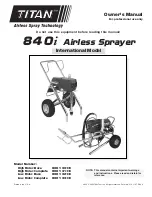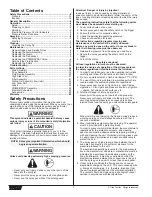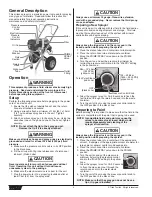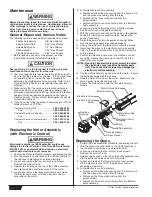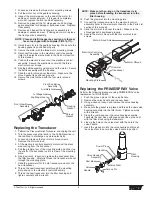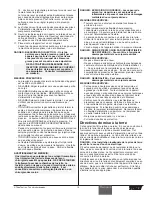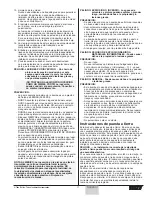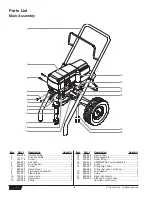
9. Attention! Please observe the following when working
inside and outside:
No solvent gasses should be carried to the unit. No
solvent gasses should form near the unit. Set up the unit
on the opposite side to the object being sprayed. When
spraying outdoors, take the wind direction into account.
When working indoors there must be sufficient ventilation
to ensure that the solvent gasses are carried away. A
minimum distance of 6.1m (20’) must be observed
between the unit and object being sprayed.
10. Extraction equipment should be installed by the user in
accordance with the local regulations.
11. The objects being sprayed must be earthed.
12. When cleaning the unit, solvent should never be sprayed
into a container with only a small opening (bunghole). An
explosive gas/air mixture is likely to form. The container
must be earthed.
13. Cleaning the unit.
A harsh jet should never be used to spray the unit. In
particular a high-pressure cleaner or high-pressure steam
cleaner should never be used. There is a danger that
water will penetrate into the unit and cause a short-circuit.
14. Pulling the trigger causes a recoil force to the hand that is
holding the spray gun.
The recoil force of the spray gun is particularly powerful
when the tip has been removed and a high pressure has
been set on the airless high-pressure pump. Therefore,
when cleaning without tip set the pressure control valve to
the lowest pressure.
15. The mains plug should always be disconnected from the
socket when work is being carried out on the electrical
components.
16. Work or repairs should only be carried out on electrical
equipment by a trained electrician, even if the work is
described in the operating instructions. No liability will be
accepted for incorrectly installed electrics.
17. Positioning when the ground is uneven.
The front of the unit must point downward so that the
machine does not slip away.
HAZARD: INJECTION INJURY - A high pressure stream
of paint produced by this equipment can pierce
the skin and underlying tissues, leading to
serious injury and possible amputation.
PREVENTION:
• The maximum operating range of the unit is 228 BAR
(3300 PSI) fluid pressure.
• NEVER aim the gun at any part of the body.
• NEVER allow any part of the body to come in contact with
the fluid stream. DO NOT come in contact with a fluid
stream created by a leak in the fluid hose.
• NEVER put your hand in front of the gun. Gloves will not
provide protection against an injection injury.
• ALWAYS lock the gun trigger, shut the fluid pump off and
release all pressure before servicing, cleaning the tip
guard, changing tips, or leaving unattended. Pressure will
not be released by turning off the engine. The
PRIME/SPRAY knob must be turned to PRIME to relieve
the pressure. Refer to the PRESSURE RELIEF
PROCEDURE described in this manual.
• The tip guard must always be in place while spraying. The
tip guard provides some protection against injection
injuries but is mainly a warning device.
• ALWAYS remove the spray tip before flushing or cleaning
the system.
• The paint hose can develop leaks from wear, kinking and
abuse. A leak is capable of injecting material into the skin.
Inspect the paint hose before each use.
DO NOT TREAT AN INJECTION INJURY AS A
SIMPLE CUT! Injection can lead to
amputation. See a physician immediately.
HAZARD: EXPLOSION OR FIRE - Solvent and paint fumes
can explode or ignite, causing property damage
and/or severe injury.
PREVENTION:
• Fire extinguishing equipment must be present and in good
working order.
• Use only conductive or earthed high pressure fluid hoses
for airless applications. Be sure that the gun is earthed
properly through hose connections.
• The pump must be connected to an earthed object. Use
the green earthing wire to connect the pump to a water
pipe, steel beam, or other electrically earthed surface.
• When flushing equipment use the lowest possible
pressure.
HAZARD: EXPLOSION HAZARD DUE TO INCOMPATIBLE
MATERIALS- May cause property damage or
severe injury.
PREVENTION:
• Do not use bleach.
• Do not use halogenated hydrocarbon solvents such as
methylene chloride and 1,1,1 - trichloroethane. They are
not compatible with aluminum and may cause an
explosion. If you are unsure of a material’s compatibility
with aluminum, contact your coating's supplier.
HAZARD: GENERAL - May cause property damage or
severe injury.
PREVENTION:
• This high pressure airless pump is designed to be used
with manufacturer authorized parts only. When using this
pump with parts that do not comply with the minimum
specifications and safety devices of the pump
manufacturer, the user assumes all risks and liabilities.
• Before each use, check all hoses for cuts, leaks, abrasion
or bulging of cover, as well as damage or movement of
couplings. If any of these conditions exist, replace the
hose immediately. Never repair a paint hose. Replace it
with another earthed hose.
• Wear protective eyewear.
• Do not spray on windy days.
Earthing Instructions
This product must be earthed. In the event of an electrical
short circuit, earthing reduces the risk of electric shock by
providing an escape wire for the electric current. This product
is equipped with a cord having an earthing wire with an
appropriate earthing plug. The plug must be plugged into an
outlet that is properly installed and earthed in accordance with
all local codes and ordinances.
DANGER — Improper installation of the earthing plug can
result in a risk of electric shock.
If repair or replacement of the cord or plug is necessary, do not
connect the green earthing wire to either flat blade terminal.
The wire with insulation having a green outer surface with or
without yellow stripes is the earthing wire and must be
connected to the earthing pin.
Check with a qualified electrician or serviceman if the earthing
instructions are not completely understood, or if you are in
doubt as to whether the product is properly earthed. Do not
modify the plug provided. If the plug will not fit the outlet, have
the proper outlet installed by a qualified electrician.
NOTE TO PHYSICIAN:
Injection into the skin is a traumatic injury. It is
important to treat the injury surgically as soon as
possible. DO NOT delay treatment to research toxicity.
Toxicity is a concern with some coatings injected
directly into the blood stream. Consultation with a
plastic surgeon or reconstructive hand surgeon may be
advisable.
© Titan Tool Inc. All rights reserved.
3

